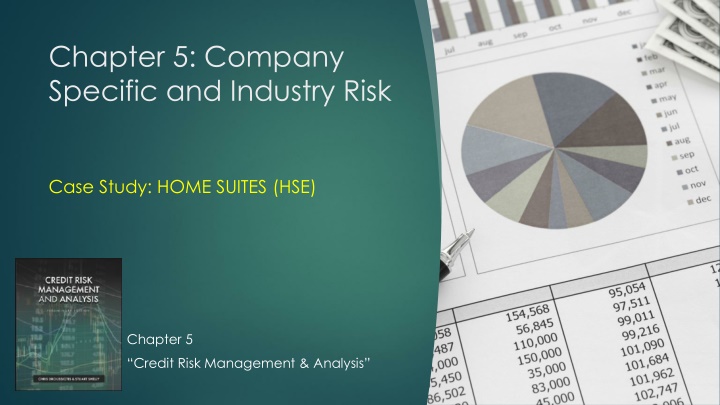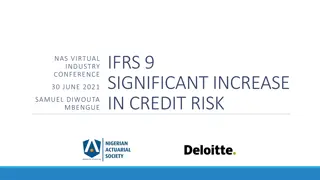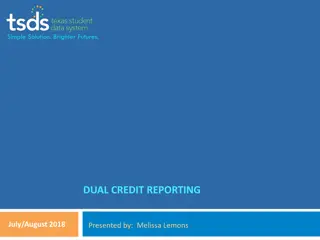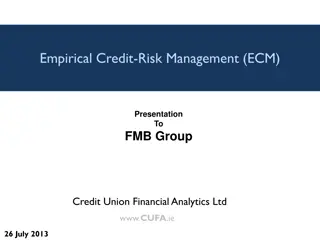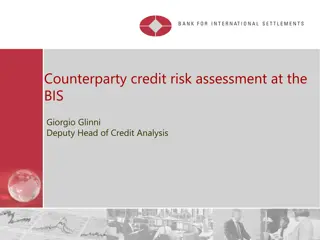Comprehensive Credit Analysis Process for Risk Management
Explore the credit analysis process for effective risk management, covering aspects such as requested amounts, profitability analysis, collateral analysis, industry analysis, and both quantitative and qualitative analyses. Learn about the key parameters considered in establishing internal ratings and the importance of in-depth qualitative analysis in assessing critical borrower success factors.
Download Presentation

Please find below an Image/Link to download the presentation.
The content on the website is provided AS IS for your information and personal use only. It may not be sold, licensed, or shared on other websites without obtaining consent from the author.If you encounter any issues during the download, it is possible that the publisher has removed the file from their server.
You are allowed to download the files provided on this website for personal or commercial use, subject to the condition that they are used lawfully. All files are the property of their respective owners.
The content on the website is provided AS IS for your information and personal use only. It may not be sold, licensed, or shared on other websites without obtaining consent from the author.
E N D
Presentation Transcript
Chapter 5: Company Specific and Industry Risk Case Study: HOME SUITES (HSE) Chapter 5 Credit Risk Management & Analysis
Credit Analysis Process Overview A typical application includes the following analysis: The requested amount Recommended participation amounts by tranche (revolving credit/term loans or pro rata) Term, structure, and conditions of the loans Profitability analysis and risk-adjusted return on capital (RAROC) The syndication strategy Transaction discussion, including sources and uses and capital structure Company discussion, including historical performance and business prospects and outlook Corporate structure, including holding company, subsidiaries, and any guarantors of the loans
Credit Analysis Process Overview (Continued) A typical application includes the following analysis: Management biographies/equity sponsor profile Collateral analysis Industry analysis Financial analysis (projections model) Internal rating analysis Internal legal review Anti-money laundering, know your customer (KYC), and other compliance reviews
Credit Analysis Process Overview (Continued) QUANTITATIVE ANALYSIS: The quantitative analysis for establishing the internal rating, which measures the probability of default and the potential loss given event of default, is based on the following parameters (each component is weighted at a specific level of importance, which may vary by bank and within each bank by type and structure of loan ABL vs. wholesale, revolver vs. term loan): Leverage Ratio Capitalization Ratio(s) Coverage Ratio Sensitivity Analysis/Variance to Projections Industry Adjustments
Credit Analysis Process Overview (Continued) QUALITATIVE ANALYSIS: Each institution will expect a level of depth of analysis, scrutiny, and research be conducted to support various elements of a credit analyst s review, which are less quantitative in nature and rather rely on subjective views regarding critical borrower success factors. The qualitative analysis is subjective based on each bank s internal policy. Strength of Management Support From a Private Equity Sponsor Loan Recovery Analysis Competitive Analysis Supply Chain Analysis Financial Forecast Execution Risks Identification and Mitigant Analysis.
CASE STUDY: HOME SUITES (HSE)
CASE STUDY: HOME SUITES (HSE) SYNOPSIS Client Inquiry. Michelle is a vice president on Drou Bank Corporation s ( DBC or Drou Bank ) Leveraged Finance team. One day, Michelle receives a phone call from SperInv, a long-term PE sponsor client of the bank. SperInv explains that, along with another PE firm ( AllStar ), they are planning to buy a currently publicly traded company (the Target ). Because DBC has been supportive of their past transactions, SperInv considers DBC a core relationship bank. SperInv would like to invite DBC to be part of the financing for the LBO of the Target. The bank commitment deadline is in a week and a half, which means Michelle must receive internal approvals (credit, legal, compliance) and sign the corresponding engagement letter and fee letter before that. After DBC signed the NDA, SperInv sent Michelle the deal materials which include the historical financial statements, sources and uses of the LBO, term sheet, financial projection and their assumptions, investor presentation containing details of the transaction, the target company, and the industry.
CASE STUDY: HOME SUITES (HSE) SYNOPSIS Client Inquiry. Form Deal Team. Michelle quickly forms a deal team of three and starts the internal process. Michelle is the deal team leader who oversees monitoring the process and communicating with the external and internal parties involved in the transaction. John, an associate on the team, will assist Michelle in internal processes and work with Mia, an analyst on the team, to complete the internal credit application and gather documents for internal legal, KYC, and compliance purposes. Each deal team is structured to suit the needs of the transaction and the proclivities of the institution, and the staffing supports the requisite roles demanded by the circumstances. A deal team is typically composed of the following: Leader Associate Analyst
CASE STUDY: HOME SUITES (HSE) TRANSACTION BACKGROUND Home Suites Inc. (the Company or HSE ) together with its subsidiaries, owns, operates, and franchises hotels in the United States. As of December 31, 2020, the Company s hotel network consisted of 775 hotels operated under the brand name Home Suites, of which the Company owns 676 and franchises 99. HSE competes against other similar hotel brands in the mid-priced, extended-stay segment of the lodging industry. It serves customers who require a week or longer stay. Founded in 1991, the Company is headquartered in New York City, New York. Transaction Announcement by PE Firms SuperInv and AllStar announce that the two PE firms have formed a consortium to buy Home Suites Inc. for $7.6 billion. As bookings plunged across the U.S. hotel industry in 2020 due to the COVID-19 pandemic, Home Suites, which specializes in economy temporary housing for health-care professionals, proved to be stronger than its peers. The PE firms offer of $22.50 per share represents a premium of 20% of HSE s share closing price on April 2. Shares of HSE rose more than 22% before the opening bell.
CASE STUDY: HOME SUITES (HSE) CREDIT APPLICATION BUSINESS PROFILE Mia, the analyst of the deal team, completes the following business profile as part of the credit application. The business profile contains specific information about the company that the credit committee needs to know about the potential borrower of the bank to make a credit decision.
CASE STUDY: HOME SUITES (HSE) Business and History: Home Suites Inc ( Home Suites, the Company, NYSE: HSE) Founded in 1991, Home Suites is a hotel chain headquartered in New York, United States. It owns, operates, and manages a hotel network of around 780 hotels in the United States. As of December 31, 2020, the Company owned and operated 676 hotels with 74,400 rooms with 8,900 employees. It serves customers in the mid-priced extended-stay segment of the hotel and lodging industry. The Company also licenses its Home Suites brand to third-party franchisees. As of December 31, 2020, the company franchised 99 hotel properties, approximately 10,500 rooms. The Company s extended-stay hotels offer customers an alternative option to traditional rental apartments and hotels. The average length of stay is approximately a month with the flexibility of shorter or longer terms upon clients requests. By contrast, the typical length of stay is over 6 months for traditional rental apartments and 3 5 days for traditional hotels. The rooms are fully furnished with in-room kitchens and other complimentary amenities that are normally available in a hotel: breakfast, free Wi-Fi, TVs, and housekeeping service, which is typically provided weekly.
CASE STUDY: HOME SUITES (HSE) History 1991: The company was founded in New York as a family-owned vacation hotel Suites. 1996: The family-owned hotel was acquired by a hotel developing firm, HDeveloper, andstarted to operate under the brand name Home Suites. 1997 2001: The company started to expand through selective acquisitions of extended-stay hotels nationwide. 2003: Home Suites Inc was formally incorporated as a result of a spin-off from Hdeveloper and started to operate as a stand-alone hotel chain company. 2006: The franchise business model was launched to let third parties join the hotel chain via franchise agreements. The company further expanded its footprint in the United States. 2009: Following the financial crisis, the company brought in a new management team. The new management team started the reevaluation process of the company s business model and strategies.
CASE STUDY: HOME SUITES (HSE) History 2010: As a result of the new management s reevaluation process, the company focused its operations mainly on the midpriced extended-stay segment of the hotel and lodging industry. 2011: The company launched IPO and started to be publicly traded in the New York Stock Exchange under the ticker HSE. 2015: Chris Smith joined the firm as CEO as the previous CEO announced his retirement. Chris later hired Daniel Brandel as CFO of the company. 2020: As the COVID-19 pandemic negatively impacted the global economy, as well as the lodging industry, the company incorporated new business strategies to provide temporary stay for health-care providers and offered quarantine services for travelers. The company also won contracts from the local government as a provider of shelters to homeless people to prevent the spread of the virus. 2021: A consortium formed by private equity firms, SuperInv and AllStar, announced the acquisition of Home Suites.
CASE STUDY: HOME SUITES (HSE) Ownership and Management Upon the closing of the proposed LBO transaction, the Company will be privately owned by private equity firms SuperInv (60%) and AllStar (40%). Sponsors (Private Equity Firm) SuperInv. SuperInv, formed in 1990, is a global private equity firm with a focus on real estate and a total of approximately 600 employees managing $137.2 billion of total assets under management ( AUM ) as of December 31, 2020. The firm pursues companies in both established and growth-oriented stages. Through its 30 years of investment in real estate, it has acquired several hotel businesses and successfully grown the business with an average internal rate of return ( IRR ) of 32% of its hotel portfolio. SuperInv has a dedicated team consisting of hotel industry experts with an average of over 20 years of experience. Those professionals have proven success in achieving SuperInv shotel portfolio companies growth and operational improvements.
CASE STUDY: HOME SUITES (HSE) AllStar. AllStar, incorporated in 1986, is one of the world s biggest private equity firms with over 750 employees globally and $201.2 billion of total AUM as of December 31, 2020. It has a diversified portfolio, spanning industries, geographies, and strategies. The firm has delivered strong investment results across economic cycles and business stages. It recently closed the fundraising of FUND IV with a total committed capital of $60 billion. The fund will be designated to investment in categories of real estate on a global basis. Since its inception, AllStar has successfully executed its investment strategies.
CASE STUDY: HOME SUITES (HSE) PROFORMA CORPOPATE STUCTURE SuperInv LLC AllStar LLC 60% 40% Proforma Corporate Structure Home Suites Holdings LLC ( Holdings ,"Guarantor") Home Suites Inc ( Borrower ) Subsidiaries ("Guarantors")
CASE STUDY: HOME SUITES (HSE) Key Executives Home Suites is led by a management team with extensive industry experience in hospitality, consumer retail, and service businesses. Each key executive has over 15 years of experience and a proven track record of successfully implementing business strategies that bring both growth and improvement to the business. Chris Smith, CEO Chris Smith has served as Chief Executive Officer of HSE and has been a member of the board since 2015. Mr. Smith earned a master s degree in hotel management from a top business school and has over 20 years of experience in the lodging industry. Prior to joining HSE, Mr. Smith held various executive roles in other hotel chain brands and successfully grew the businesses during his period of service. Daniel Brandel, CFO Daniel Brandel has served as Chief Financial Officer of HSE since 2015. Mr. Brandel is responsible for developing the Company s financial strategy, business performance metrics, and corporate financial reporting. Prior to joining HSE, Mr. Brandel served as CFO of a Global Fortune 500 retail company from 2010. Mr. Brandel started his career in corporate finance in the late 1990s and served in several publicly traded and private equity backed organizations. Mr. Brandel earned his bachelor s degree and his MBA from top universities. He also obtained a certificate in management accounting. Charlotte Jones, COO Charlotte Jones has served as Chief Operating Officer since 2018. Ms. Jones has been with HSE since 2012. Ms. Jones is responsible for managing the hotel s operating. She oversees various corporate functions, including sales, human resources, product and design, rooms, food and beverage, and engineering. Prior to assuming her current position, Ms. Jones served in several senior positions at HSE, including Executive Vice President of Operations and Senior Vice President of Sales. Prior to joining HSE, Ms. Jones served as a top executive in other hotel chain businesses.
CASE STUDY: HOME SUITES (HSE) Segments and Geographic Footprint Segments The Company operates in two segments: Owned Hotels (82.1.5% of total revenue). The Owned Hotels segment is the Company s primary segment and accounted for 82.1% of total revenue for the fiscal year ended December 31, 2020. Revenues are generated from the operation of 676 Company-owned hotel properties. Franchised Hotels (17.9% of total revenue). Revenues of the 99 Franchised Hotels segment are from fees under various franchise and management agreements and accounted for 17.9% of total revenues for the fiscal year ended December 31, 2020. The franchise contracts provide third parties access to HSE s system-wide platforms and/or management services, as well as the right to use the brand name Home Suites.
CASE STUDY: HOME SUITES (HSE) Segments and Geographic Footprint Geographic Footprint As of December 31, 2020, HSE operated in 38 states in the United States with a concentration of popular business and vacation designation states. Out of the total 84,900 system-wide rooms, 14.8% were in New York, 11.3% were in California, 9.2% were in Florida, 5.9% in Texas, 5.4% in Arizona, and 5.2% in New Jersey. HOME SUITES INC.(HSE) State # of Owned Hotels# of Franchised Hotels Total # of Hotels # of Rooms % of Total Rooms 15.2% New York 99 15 114 12,605 11.5% California 70 17 87 9,592 9.4% Florida 58 10 68 7,822 6.0% Texas 37 8 45 4,996 5.5% Arizona 37 6 43 4,601
CASE STUDY: HOME SUITES (HSE) Customers Home Suites typical customers are business travelers on business trips, assignments, or training programs; relocated corporate employees during their search for new houses and apartments to settle; leisure travelers looking for a longer stay in a home-style apartment with key amenities, such as a kitchen, while still having access to managed housekeeping services; and home buyers or anyone in need of a temporary home.
CASE STUDY: HOME SUITES (HSE) Business Strategies The management team of Home Suites has been focusing on increasing brand awareness, building a long-term relationship with intuitional clients, and improve service quality to stand out among investors: Increase Brand Awareness Build Long-Term Corporate Relationships Continues Focus on Quality.
CASE STUDY: HOME SUITES (HSE) Competition and Market Share Competition Home Suites competes in the highly competitive extended-stay segment of the Hotels and Lodging industry. Competition comes from other extended-stay hotel brands, traditional hotels looking to expand into the extended-stay segment, as well as alternative lodging businesses, such as serviced apartments and private homeowners renting through various digital platforms (websites, marketplace on social media, mobile apps, etc.). The Company also sees competition in attracting potential franchisees, as it s the main source of growing the scale of business. Players in the hotel and lodging industry have been aggressively expanding market shares through franchising. Market Share Home Suites business is focused on the mid-priced extended-stay segment of the industry, which accounted for approximately one third of the extended-stay rooms in 2020, per ABC research s Industry Report on Extended- Stay Segment of Lodging Industry published in February 2021. The Company has approximately 19% market share based on revenue.
CASE STUDY: HOME SUITES (HSE) Competition and Market Share Key Competitors XX Hotel. Direct competitor with approximately 25% market share of the mid-price extended-stay segment YY Hotel. A key player in the hotel and lodging industry but currently mainly in the luxury segment, looking to expand into the mid-price segment ZZ Hotel. A key player in the economy (low-priced) extended-stay segment
CASE STUDY: HOME SUITES (HSE) Environmental, Health, and Safety Matters Both the Company s owned and franchised hotel properties are subject to various regulations that make the hotels responsible for cleaning up hazardous contaminations from the property and natural resource damage arising from those contaminations. The consequences of breaking those laws would be several, resulting in penalties and huge costs of remediation, as well as damages to the Company s reputation. Both the private equity sponsors and Home Suites management team realize the importance of being in compliance with corresponding environmental, health, and safety regulations and laws. The Company has been and will continue to focus on actively monitoring the emission of hazardous contaminations at or from hotel properties, investing in sustainable and environmentally friendly technologies, and making timely and transparent disclosure of its efforts and results on corresponding matters.
CASE STUDY: HOME SUITES (HSE) Key Advantages The Company has the following key competitive advances: Seasoned Private Equity Sponsors and Management Team. Both the private equity sponsors, SuperInv and AllStar, have decades of experience in running hotel businesses from various stages and a track record of achieving growth and high returns under the sponsors ownership. The current management team has been successfully running Home Suites for years. During the COVID-19 pandemic, the management team adapted to the new challenges, came up with new strategies quickly, and delivered a relatively stronger performance in 2020 compared to other hotel businesses. This demonstrates the management s ability and business acumen, even through challenging times. Well-Known Brand Name. Due to the Company s years of effort in building its brand awareness and through its geographic expansion, as well as continuous focus on quality, it ranked as the #2 brand in XYZ Research s market survey (published in August 2020) on the mid-priced extended- stay segment. The Company holds a 19% market share and currently operates a hotel network in 38 states, making it one of the top players in the segment. Proven Resilient Business Model. The Company has benefited from its long-term partnerships with institutional clients as a housing provider for off-sight assignments and training programs. Corporate travel needs are recurring in nature and thus provide Home Suites with more stable and foreseeable revenue. The Company is also committed to continue expanding its footprint and differentiate service offerings to attract more customers.
CASE STUDY: HOME SUITES (HSE) RISKS MITIGANTS Cyclicality and Seasonality As the general hotel and lodging industry is cyclical and seasonal in nature, the Company s business is tied to the economic cycle and subject to seasonal fluctuations. Home Suites has a proven resilient business model that focuses on building long-term partnerships with institutional clients, which brings more reliable revenue streams. The Management team demonstrated strong business acumen during the COVID-19 pandemic by deploying new strategies adapted to the challenges when the global economy was heavily disrupted. Revenue is generally lower during the first and fourth quarters of each calendar year. Compared to traditional hotels, hotels in the extended- stay segment offer home- style rooms with kitchenettes and have been popular among travelers looking for vacation stays during holiday seasons (first and fourth quarters).
CASE STUDY: HOME SUITES (HSE) RISKS MITIGANTS Increased Competition The extended-stay segment has been highly competitive and gained increasing attention from traditional hotels, as well as private homeowners. Home Suites is currently the industry-leading player with #2 brand awareness, which makes it the preferred hotel for travelers. The Company s new business strategies will focus on digital platforms penetration and differentiated pricing and service offerings, which will compete against industry newcomers. Compared to private homeowners, well-known hotel chains are a more reliable and safer source of housing with professional high standard quality of service. RISKS MITIGANTS Higher Labor and Operating Expenses From Accelerated Inflation As U.S. inflation is expected to rise over the medium term, corporations are facing rising operating costs, which will put pressure on margins. When Home Suites experienced high inflation environments in the past, the Company managed to mitigate the impact by passing through the cost to customers and improving operating efficiencies. Home Suites focus on growth through hotel franchising, which has higher margins than owned hotels, will improve the over margins of the Company
CASE STUDY: HOME SUITES (HSE) RISKS MITIGANTS Tightening Regulations on Environmental, Health, and Safety Matters Both the Company s owned and franchised hotel properties are subject to various regulations on environmental, health, and safety matters. The Company has been investing in sustainable and environmentally friendly technologies that minimize the impact of hotel operation on the environment. Both the sponsors and management are committed to developing enhanced procedures and mandatory training for employees to comply with the regulations. The Company has also been hiring industry experts and expanding its Environmental, Social, and Governance ( ESG ) team to ensure compliance with federal, state, and local laws. Home Suites are facing tightening rules and rising standards of disclosure.
CASE STUDY: HOME SUITES (HSE) INDUSTRY ANALYSIS After completing the business profile, the deal team completed a comprehensive industry analysis, with the primary original work product being completed by Mia and reviewed for completeness, thoroughness, and accuracy by the associate and finally by Michelle as the team leader. The industry analysis part of the credit application focuses on the key characters of the industry in which the borrower competes, the current development and outlook, and any industry-specific factors that could impact the borrower s business. Summary: The Extended-Stay Segment of the Hotel and Lodging Industry in the United States Extended-stay hotels offer apartment-like rooms with kitchenettes with a homely and comfortable feeling. Guests have the flexibility to check out or extend the stay whenever they wish without being bound to a contract or a fixed-term lease. Extended-stay hotels represent a growing segment within the U.S. lodging industry. Based on type, the market is divided into luxury, middle (mid-priced), and economy type extended-stay hotels.
CASE STUDY: HOME SUITES (HSE) Key Characters Cyclicality and Seasonality The overall hotel and lodging industry performance is generally tied to both macro and microeconomic cycles and is seasonal in nature, with revenues generally lower during the first and fourth quarters of each calendar year. The extended-stay segment, though, is relatively less cyclical and seasonal. Its flexible terms of stay and apartment-like styles have gained popularity with people looking for temporary homes when settling down in new cities and towns. The extended-stay hotels have also become the preferred choice during holiday and skiing seasons. Higher Barriers to Entry The lodging industry requires heavy capital investments for the hotel buildings and rooms, corresponding amenities, IT infrastructure, personnel recruiting, and training. Reputations are also key to success in the industry, as travelers tend to choose well-known hotel chains for a guaranteed quality of service.
CASE STUDY: HOME SUITES (HSE) Highly Competitive With New Thread From Private Homeowners The extended-stay segment is highly competitive. Through years of integration efforts via acquisition and franchising, top plays accounted for more than 50% share of the market. The remaining markets are highly fragmented with many local hotel operators. Traditional hotel brands have also shown interest in the extended- stay segment, which further increases the completions. Furthermore, technology renovations have granted private homeowners access to the market and travelers via online platforms, mobile apps, and social media marketing.
CASE STUDY: HOME SUITES (HSE) Growth Drivers A key indicator of the industry is revenue per available room ( RevPar ), which is calculated by average daily rate ( ADR, price charged per room) times occupancy rate. RevPar is impacted by the following factors: Economic Growth. As the economy grows, so does consumer and business spending, which will result in increased business and leisure travel, thus increasing demand for hotels. Growth in International and Domestic Tourist Industry. Demand from tourists has always been a key driver of the industry and the main source of revenue generation. U.S. Housing Market. Extended-stay hotels offer home buyers temporary housing that doesn t require signing a fixed-term lease. As the housing market grows, so does the demand for extended-stay hotels while home buyers settle transactions.
CASE STUDY: HOME SUITES (HSE) Current Trend The COVID-19 pandemic has caused governments across the globe to implement unprecedented lockdowns and shelter-in-place orders, which adversely disrupted the global economy. The overall hotel and lodging industry is highly tied to the economic cycle; thus, it also experienced a significant decline in 2020 with RevPar dropped by 41.7% year over year for 2020. The extended-stay segment is relatively more resilient than traditional hotels. Within the extended-stay segment, the mid-priced segment saw the least decline in 2020 with a decline in RevPar below 30% driven by both reduced ADR and occupancy rate. ADR for the mid-priced extended-stay hotels dropped by approximately 15% in 2020. The total supply of rooms in 2020 remained stable, as many acquisitions were put on pause because of the pandemic.
CASE STUDY: HOME SUITES (HSE) Industry Outlook Post-pandemic, the extended-stay hotel market is expected to see a recovery back to the pre-pandemic level in 2022. Both ADR and occupancy rate are expected to see a gradual recovery in late 2021 and the first half of 2022. ADR is expected to further grow as hotels will pass through increased costs resulting from a rising inflation environment.
CASE STUDY: HOME SUITES (HSE) HISTORICAL FINANCIAL PERFORMANCES After receiving historical financials from the sponsor, Mia spreads the provided financial statements of HSE into DBC s internal financial summary template and conducts the analysis of historical financial performance with a focus on the most recent fiscal year.
INCOME STATEMENT Dec 31 2020 Dec 31 2019 Dec 31 2018 Dec 31 2017 Dec 31 2016 ($000's) Owned Hotels Franchised Hotels Total Revenue Cost of Revenue Gross Profit Total Operating Expenses EBIT (Operating Income or Loss) Interest Expense EBT & other Income/Expenses Other (Income)/Expenses Net EBT Income Tax Expense Net Income 1,027,040 1,414,251 1,376,211 1,339,915 1,233,730 223,739 47,612 153,859 199,355 290,981 1,250,779 1,461,863 1,530,071 1,539,270 1,524,712 712,512 721,429 715,495 702,654 696,926 538,267 740,434 814,576 836,616 827,785 357,814 351,028 359,705 385,091 383,195 180,454 389,406 454,871 451,525 444,590 146,755 140,480 139,618 142,212 153,160 33,698 248,926 315,253 309,313 291,431 (52,409) 15,582 10,655 31,271 54,187 86,107 233,344 304,598 278,042 237,244 58,187 149,742 169,162 183,426 153,325 27,920 83,602 135,437 94,616 83,918 CASE STUDY: HOME SUITES (HSE) 180,454 389,406 454,871 451,525 444,590 201,916 187,122 94,884 208,662 230,196 382,369 576,528 549,755 660,187 674,786 EBIT Depreciation and Amortization EBITDA
CASE STUDY: HOME SUITES (HSE) HISTORICAL FINANCIAL PERFORMANCES Revenues from owned hotels segment were stable before 2020, driven by the steady growth of RevPar and the number of rooms. In 2020, the global economy was significantly disrupted by the COVID-19 pandemic. To combat the spread of the virus, global governments have implemented travel restrictions and shelter-in-place orders, which resulted in cancellations of travelers hotel bookings and revenue decline in the hotel and lodging industry. To mitigate the impact, the management quickly adjusted to the situation and implanted a temporary strategy to offer temporary housing solutions for traveling healthcare providers, people without a home sponsored by local governments, and essential travelers subject to mandatory quarantine requirements.
CASE STUDY: HOME SUITES (HSE) HISTORICAL FINANCIAL PERFORMANCES Revenues from franchised hotels segment are mainly royalty fees from franchisees. Revenues declined by double digits from 2016 to 2019 mainly because of the termination of franchise agreements. The majority was due to management s quality control efforts since the new CEO and CFO joined the firm in 2015. To maintain the high standard of services associated with the brand name, franchised hotels that didn t meet the quality standard were terminated. In 2020, revenues increased in the franchised hotels segment because of new franchise agreements as a result of management s focus on growth through the franchising business.
CASE STUDY: HOME SUITES (HSE) HISTORICAL FINANCIAL PERFORMANCES Gross margin decline before 2020 was due to the decrease in franchise revenue, which is a higher margin component of the total revenue. Margin decline was also a result of industry-wide wage increase, especially the hourly wage of temporary workers hired during peak seasons. The gross margin decline in 2020 was driven by reduced RevPar as a combination of reduced ADR and occupation rate during the COVID-19 pandemic. EBITDA/EBITDA margin has improved since 2017 due to management s continued effort on operational efficiencies. In 2020, the deterioration was due to reduced gross profit and increased operating expense during the COVID-19 pandemic driven by disinfecting products, personal protective equipment for employers, and other associated expenses.
OPERATIONAL METRICS Dec 31 2020 Dec 31 2019 Dec 31 2018 Dec 31 2017 Dec 31 2016 Average Daily Rate (ADR) ADR Price Increase % Occupancy Rate RevPar RevPar Increase % Number of Rooms Number of Rooms Increase % $ (13.23%) 61.0% 37.82 $ (27.50%) 74,400 0.16% 62.0 $ 71.5 6.30% 73.0% 52.16 2.10% 74,280 0.65% 67.2 0.70% 76.0% 51.09 2.04% 73,800 0.65% $ $ 66.8 6.98% 75.0% 50.07 8.43% 73,320 0.16% $ 62.4 74.0% 46.18 $ $ $ $ 73,200 CASE STUDY: HOME SUITES (HSE) Owned Hotels Revenue Growth Franchised Hotels Revenue Growth Revenue Growth -27.4% 369.9% -14.4% 2.8% -69.1% -4.5% 2.7% -22.8% -0.6% 8.6% -31.5% 1.0% PROFITABILITY RATIO Gross Margin EBITDA Margin EBIT Margin 43.0% 30.6% 14.4% 50.7% 39.4% 26.6% 53.2% 35.9% 29.7% 54.4% 42.9% 29.3% 54.3% 44.3% 29.2%
SUMMARY CASH FLOW ANALYSIS Dec 31 2020 27,920 201,643 55,673 285,509 Dec 31 2019 83,602 187,014 4,351 275,075 Dec 31 2018 135,437 90,367 4,517 27,209 257,530 Dec 31 2017 94,616 202,956 5,706 (26,881) 276,397 ($000's) Net Income Depreciation Amortization of Intangibles Deferred Taxes Deferred Revenue (Current and Non-Current) Cash Income 272 108 - - - - Working Capital Activity Net Receivables Inventory Accounts Payable Accrued liabilities Total Working Capital Other Current Assets/Liabilities Operating Cash Flow (OCF) 50,420 50,794 336,302 373 282,270 6,899 27,212 29,383 286,913 2,171 (889) - - - (6,055) (6,944) 269,453 - CASE STUDY: HOME SUITES (HSE) 296 - - - - 7,195 - - - - Investment Activities Capital Expenditure Long-Term Investment Other Long-Term Assets Total Investment Activities (144,530) (638) (145,169) (302,606) (302,086) (247,871) (247,839) (180,095) (26,705) (206,799) 520 32 - - - - Cash Flow Before Financing Activity 191,134 (19,816) 39,074 62,653 Financing Activities ST Debt LT Debt Other Long-Term Liabilities Other Financing Activities Total Financing Activities 61,183 61,183 - 164,555 164,555 - (47,113) (47,113) - (300,607) (300,607) - - - - - - - - - 252,317 144,739 (8,039) (237,954) Net Change in Cash
BALANCE SHEET STATEMENT Dec 31 2020 Dec 31 2019 Dec 31 2018 Dec 31 2017 Dec 31 2016 ($000's) Assets Current Assets Cash And Cash Equivalents Other Short Term Investments Total Cash and Cash Equivalent Account Receivables Inventory Other Current Assets Total Current Assets 564,995 564,995 16,451 581,446 312,678 312,678 16,824 329,502 167,939 167,939 23,723 191,662 175,979 175,979 25,894 201,872 413,932 413,932 25,004 438,937 - - - - - - - - - - - - - - - Non-current assets Gross Property, Plant and Equipment Accumulated Depreciation Net Property, Plant and Equipment Long Term Investments Goodwill Intangible Assets Other long-term assets Total non-current assets Total Assets 5,985,529 (1,850,383) 4,135,146 79,628 54,066 40,912 15,781 4,325,533 4,906,979 5,840,999 (1,648,740) 4,192,259 78,990 54,230 41,020 15,781 4,382,280 4,711,782 5,538,393 (1,461,726) 4,076,667 79,510 54,230 41,128 15,781 4,267,316 4,458,978 5,290,522 (1,371,359) 3,919,163 79,542 58,639 41,236 15,781 4,114,361 4,316,233 5,110,427 (1,168,403) 3,942,024 52,837 64,237 41,344 15,781 4,116,224 4,555,160 CASE STUDY: HOME SUITES (HSE) Liabilities Current Liabilities Accounts Payable Accrued liabilities Other Current Liabilities Current Deferred Revenue Current Portion of Long Term Debt Total Current Liabilities 303,838 303,838 253,417 253,417 253,121 253,121 225,908 225,908 231,964 231,964 - - - - - - - - - - - - - - - - - - - - Non-Current Liabilities Long Term Debt Deferred taxes liabilities Non-Current Deferred revenues Non-Current Deferred revenues Total Non-Current liabilities Total Liabilities 3,220,346 321,701 3,542,047 3,845,885 3,159,163 266,028 3,425,191 3,678,608 2,994,608 261,677 3,256,285 3,509,406 3,041,722 234,468 3,276,190 3,502,098 3,342,329 261,349 3,603,678 3,835,642 - - - - - - - - - - Stockholders' Equity Common Stock Additional Paid In Capital Accumulated Deficit Total stockholders' equity 1,112,560 (53,597) 1,061,094 2,131 1,112,560 (81,517) 1,033,174 2,131 1,112,560 (165,119) 949,572 2,131 1,112,560 (300,556) 814,135 2,131 1,112,560 (395,172) 719,519 2,131 4,906,979 4,711,782 4,458,978 4,316,233 4,555,160 Liabilities & Stockholders Equity
FINANCIAL RATIO ANALYSIS Dec 31 2020 Dec 31 2019 Dec 31 2018 Dec 31 2017 Dec 31 2016 LIQUIDITY RATIOS Current Ratio Quick Ratio Accounts Receivable Turnover Accounts Receivable Days Accounts Payable Turnover Accounts Payable Days 1.9x 1.9x 75.2x 4.87 2.6x 143.12 1.3x 1.3x 72.1x 5.06 2.8x 128.14 0.8x 0.8x 61.7x 5.92 3.0x 122.19 0.9x 0.9x 60.5x 6.03 3.1x 118.92 1.9x 1.9x 65.2x 5.62 2.7x 137.78 CASE STUDY: HOME SUITES (HSE) SOLVENCY RATIOS Total Debt / Total Capitalization (Cap Ratio) EBITDA/ Interest (Coverage Ratio) Total Debt / EBITDA (Leverage Ratio) Net Total Debt / EBITDA (Leverage Ratio) 75.2% 2.6x 8.4x 6.9x 75.4% 4.1x 5.5x 4.9x 75.9% 3.9x 5.4x 5.1x 78.9% 4.6x 4.6x 4.3x 82.3% 4.4x 5.0x 4.3x
CASE STUDY: HOME SUITES (HSE) HISTORICAL FINANCIAL PERFORMANCES Operating activities have generated positive cash flows to the firm. Working capital has been a source of cash flow to the firm mainly because of accounts payable, as the firm managed to negotiate favorable terms on payments and accrued expenses, especially during the COVID-19 pandemic. Deferred taxes are also a source of cash to the firm. Investment activities mainly consisted of capital expenditure for hotel expansion, renovation, and maintenance. In 2020, capital expenditure decreased, as many scheduled maintenance and expansion projects were paused because of the COVID-19 pandemic. Financing activities fluctuation was driven by payments and borrowings of long-term debts. The Company has been accumulating cash in the past 2 years. In 2020, despite the negative impact of the global health crisis on topline growth, Home Suites generated $252 million cash.
CASE STUDY: HOME SUITES (HSE) HISTORICAL FINANCIAL PERFORMANCE LIQUIDITY AND RATIOS Liquidity for the Company has been improving over the years, even during the COVID-19 pandemic, as evidenced by increasing current and quick ratios, higher accounts receivable turnover and shorter accounts receivable days, lower accounts payable turnover and longer accounts payable days, and increasing cash balance. Total leverage was over 8 times during 2020 as EBITDA decreased during the pandemic. Total debt increased as the Company refinanced existing debt in late 2020 to take a lower interest rate, resulting from the government s stimulative monetary policy to stimulate the economy. EBITDA/interest deteriorated in 2020 but remained above 2.5x.
